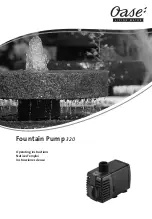
104-A00 Page 6/12
OPERATION
RUNNING THE PUMP IN REVERSE ROTATION
NOTICE:
Operate the pump in reverse rotation for no more than 10
minutes and only when a separate pressure relief valve
is installed to protect the pump from excessive pressure.
It may be desirable to run the pump in reverse rotation for
system maintenance. The pump will operate satisfactorily in
reverse rotation for a LIMITED time,
at a reduced
performance level.
FLUSHING THE PUMP
NOTICE:
If flushing fluid is to be left in the pump for an extended
time, it must be a lubricating, non-corrosive fluid. If a
corrosive or non-lubricating fluid is used, it must be
flushed from the pump immediately.
1. To flush the pump, run the pump with the discharge
valve open and the intake valve closed. Bleed air into
the pump through the intake gauge plug hole or through
a larger auxiliary fitting in the intake piping. Pump air for
30 second intervals to clean out most of the pumpage. A
drain plug is provided on the bottom of the cylinder, near
the discharge port to facilitate cleaning.
2. Run a system compatible flushing fluid through the pump
for one minute to clear out the remainder of the original
pumpage. Restrict a valve in the discharge line to build
up 10 psi (0.7 bar) to force flushing liquid through the
bearing seal chamber.
3. To flush out the pressure relief valve, close the valve in
the discharge line for 15 seconds while pumping the
flushing liquid.
4. If necessary, repeat steps 2 and 3.
5. To remove the flushing fluid, follow step 1 above.
NOTICE:
After flushing the pump some residual fluid will remain
in the pump and piping.
NOTICE:
Properly dispose of all waste fluids in accordance with
the appropriate codes and regulations.
PUMP RELIEF VALVE
Incorrect bypass valve or internal relief
valve settings can cause pump
component failure, personal injury, and
property damage.
Hazardous pressure
can cause personal
injury or property
damage
.
NOTICE:
The pump internal relief valve is designed to protect the
pump from excessive pressure and must not be used as
a system pressure control valve.
Pumping volatile liquids under suction lift may cause
cavitation. DO NOT partially close the discharge valve. This
WILL result in internal relief valve chatter. For these
applications, install an external bypass valve, and any
necessary piping, back to the storage tank. Use a bypass
system when operating for more than 1 minute (15 seconds if
a check valve is used in the suction line) against a closed
discharge valve.
RELIEF VALVE SETTING AND ADJUSTMENT
The relief valve pressure setting is marked on a metal tag
attached to the valve cover. Set the relief valve at least 15 -
20 psi (1.0 - 1.4 Bar) higher than the operating pressure, or
the external bypass valve setting (if equipped).
Incorrect settings of the pressure relief
valve can cause pump component
failure, personal injury, and property
damage.
Hazardous pressure
can cause personal
injury or property
damage
Relief valve cap is exposed to pumpage
and will contain some fluid
Hazardous or toxic
fluids can cause
serious injury.
DO NOT remove the R /V Cap OR adjust the relief valve
pressure setting while the pump is in operation.
1.
To INCREASE the pressure setting,
remove the relief
valve cap (1), and turn the adjusting screw
inwar
d
(clockwise). Retighten the locknut and replace the valve
cap.
2.
To DECREASE the pressure settin
g, remove the relief
valve cap (1), and turn the adjusting screw
outwar
d
(counterclockwise). Retighten the locknut and replace
the valve cap.
Refer to the individual Blackmer pump parts lists for various
spring pressure ranges. Unless specified otherwise, pumps
are supplied from the factory with the relief valve adjusted to
the mid-point of the spring range.






























